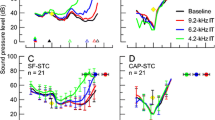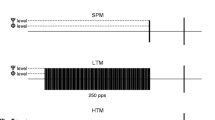Abstract
In this study, 21 guinea pigs were submitted to a single high energy impulse noise (gun shot with blank projectiles). The auditory function was evaluated over a 7-day recovery period by recording the compound action potential (CAP) from the round window. The threshold shift and input/output function (CAP amplitude and delay function of the stimulus intensity) were studied at different frequencies. CAP amplitude fell after the noise trauma, especially at the lower sound level, resulting in a threshold shift. Latency was significantly increased. During recovery, whereas latency returned to its initial value, CAP amplitude gradually increased and, in half the animals, exceeded the control value for the higher levels of stimulus. This could have been because of progressive disinhibition or recruitment, and may correspond clinically to hyperacusis. These results are discussed referring to those obtained by other authors using other methods.







Similar content being viewed by others
References
Aran JM, Dancer A, Dolmazon JM, Pujol R, Tran Ba Huy P (1988) Physiologie de la cochlée. Série audition. INSERM/FA (eds), p 69
Dancer A, Grateau P, Cabanis A, Vaillant T, Lafont D (1991) Delayed temporary threshold shift induced by impulse noises (weapon noises) in men. Audiology 30:345–356
Davis H (1983) An active process in cochlear mechanics. Hear Res 9:79–80
Emmerich E, Biedermann M, Richter F (1990) Auditory evoked responses in awake rabbits after exposure to high intensity noise impulses. Activ Nerv Super 32:119–127
Emmerich E, Richter F, Meissner W, Dieroff HG (2000) The effect of impulse noise exposure on distortion product otoacoustic emissions in the awake guinea pig. Eur Arch Otorhinolaryngol 257:128–132
Emmerich E, Richter F, Reinhold U, Linss V, Linss W (2000) Effects of industrial noise exposure on distortion product otoacoustic emissions (DPOAEs) and hair cell loss of the cochlea—long term experiments in awake guinea pigs. Hear Res 148:9-17
Gerken GM, Simhardi-Sumithra R, Bhat KHV (1986) Increase in central auditory responsiveness during continuous tone stimulation or following hearing loss. In: Plenum (eds) Basic and applied aspects of noise-induced hearing loss. Nato ASI, series a. Life Sciences 111:195–211
Hamernik RP, Ahroon WA, Hsueh D, Lei SF, Davis R (1993) Audiometric and histological differences between the effects of continuous and impulsive noise exposures. J Acoust Soc Am 93:2088–2095
Hamernik RP, Turrentine GA, Roberto M, Salvi R, Henderson D (1984) Anatomical correlates of impulse noise-induced mechanical damage to the cochlea. Hear Res 13:229–247
Henderson D, Hamernik RP (1986) Impulse noise: critical review. J Acoust Soc Am 80:569–584
Homma T, Hasegawa M, Yokovama K, Tamura T (1994) Temporary change of compound action potential amplitude after intense sound exposure. ORL 56:19–23
Job A, Raynal M, Rondet P (1999) Hearing loss and use of personal stereos in young adults with antecedents of otitis media. Lancet 353:35
Katzenell U, Segal S (2001) Hyperacusis: review and clinical guidelines. Oto Neurotol 22:321–327
Kuokkanen J, Virkkala J, Zhai S, Ylikoski J (1997) Effect of hyperbaric oxygen treatment on permanent threshold shift in acoustic trauma among rats. Acta Otolaryngol [Suppl] (Stockh) 529:80–82
Labarère J, Lemardeley P, Vincey P, Desjeux G, Pascal B (2000) Traumatisme sonores aigus en population militaire. La presse médicale 29:1341–1344
Liberman MC, Dodds LW (1984) Single-neuron labelling and chronic cochlear pathology. III: stereocilia damage and alterations of threshold tuning curves. Hear Res 16:55–74
Luz GA, Hodge DC (1971) Recovery from impulse-noise induced TTS in monkeys and men: a descriptive model. J Acoust Soc Am. 49:1770–1777
Pekkarinen J (1995) Noise, impulse noise, and other physical factors combined effects on hearing. Occup Med 10:545–59
Rajan R (1992) Protective functions of the efferent pathways to the mammalian cochlea: a review. In: Dancer A et al (eds) Noise induced hearing loss. Mosby Year Book, St. Louis, pp 429–444
Sellick P, Patuzzi R, Robertson D (2003) Primary afferent and cochlear nucleus contributions to extracellular potentials during tone-bursts Hear Res 176:42–58
Suc B, Poulet M, Asperge A, Vix J, Barberot JP, Doucet F (1994) Clinical development of acute noise-induced acoustic trauma. An evaluation of a study of 250 cases. Ann Otolaryngol Chir Cervicofac 111:319–324
Wang J, Ding D, Salvi RJ (2002) Functional reorganization in chinchilla inferior colliculus associated with chronic and acute cochlear damage Hear Res 168:238–249
Acknowledgements
The authors thank Prof. J.L. Puel, Dr. A. Dancer and Dr. J. Viret for their valuable advice or technical assistance. This study was supported by the "Direction des Systèmes de Force et de la Prospective, Département des Techniques des Sciences du Vivant", DGA.
Author information
Authors and Affiliations
Corresponding author
Rights and permissions
About this article
Cite this article
Sendowski, I., Braillon-Cros, A. & Delaunay, C. CAP amplitude after impulse noise exposure in guinea pigs. Eur Arch Otorhinolaryngol 261, 77–81 (2004). https://doi.org/10.1007/s00405-003-0647-2
Received:
Accepted:
Published:
Issue Date:
DOI: https://doi.org/10.1007/s00405-003-0647-2




